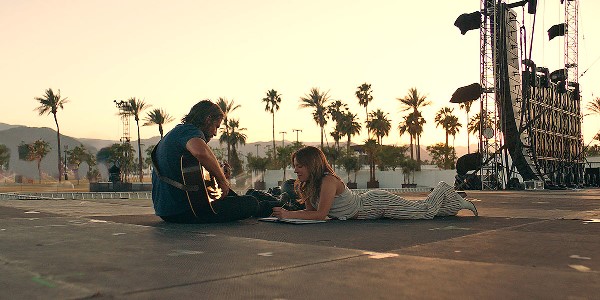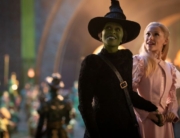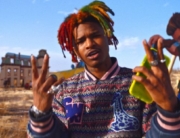The screenplay credits for the latest reiteration of A Star Is Born lists the duo of William Wellman and Robert Carson, who won the Academy Award for Best Original Story for the 1937 film (Dorothy Parker was among the many who worked on that screenplay); Moss Hart, who wrote the 1954 musical extravaganza; and the writing team behind the 1976 version. But the story’s genesis goes back even further than Wellman and Carson’s rendering, which itself was a remake of 1932’s What Price Hollywood? The dialogue in the glamorous 1937 and 1954 versions sparkled and snapped, but rather than look to those examples, actor-turned-debut director Bradley Cooper and his team instead sought inspiration from the weakest of the whole bunch, the dramatically inert 1976 Barbra Streisand vehicle written by John Gregory Dunne, Joan Didion, and Frank Pierson (its director). From that film, which the critics panned at the time, Cooper has borrowed the rock ‘n’ roll backdrop and pedestrian dialogue and, in some ways, its 1970s setting.
Perhaps a synopsis is not necessary, although based on one gasp at the press screening, not everyone is familiar with this well-trodden and slightly hackneyed story. So here it is: A young, multitalented artist, mentored by her older superstar husband, rises to the top while he self-destructs and stumbles his way toward becoming a has-been.
Cooper follows in the footsteps of Streisand’s co-star Kris Kristofferson, taking on the role of a laid-back country rocker, who this time around goes by the porn star–sounding name of Jackson Maine. Jack, to his friends, downs several bottles of hard liquor a day, all varieties of pills, and last, but not least, enjoys a bump or two of cocaine, whether in his limo or dressing room. Cooper’s flushed face mirrors Jack’s drug intake, though his physique remains movie star–toned and muscular.
The soundtracks of the 1976 and 2018 versions are almost interchangeable, reminiscent of the California Sound and a mix of Lynyrd Skynyrd and other Southern rock bands, both of which are styles of music that haven’t topped the charts in decades. Both films pay homage to, and are indebted to, the Woodstock-era concerts films that were influenced by such filmmakers as D. A. Pennebaker. Cooper borrows from the best of the 1976 playbook, including the anything-goes, on-the-fly vibe that comes from the handheld concert footage, which gives the narrative an edge, just as it had 40 years ago.
As has been widely reported, Cooper sings in real time, as does his co-star, Lady Gaga—a duet was shot on the stages at the Coachella festival. For this role, Cooper lowered his voice an octave or two. Veteran actor Sam Elliott appears as Jack’s older brother, and when these two gravelly voices snipe at each other, it’s a scenario straight out of 30 Rock, when Alec Baldwin and Will Arnett compete to see who is the toughest in a “talking like this” contest.
Gaga plays Ally, the unknown singer who becomes a household name virtually overnight, and who is in the mode of an early-’70s singer-songwriter, at least during the movie’s first half. The music she performs reflects the direction of Gaga’s last album, the stripped-down Joanne, rather than her synth dance pop from the mid-2000s. (Though there is a by-the-numbers dance song thrown in, but more on that later.)
Ally is portrayed as an outsider artist performing on the periphery of show business without any connections, but what sets this particular reiteration apart is the character’s ambition, which makes her less of a piece of clay to be molded than in the other movies. She knows what she wants and takes advantage of all the advice the music industry has to offer. For her debut on Saturday Night Live, Ally performs a dance song that is both forgettable and risible—Cooper’s film has something in common with the new film Vox Lux, with Natalie Portman, as both feature songs that are deliberately banal and overproduced. Ally is also not envisioned as a pure but naïve artist untainted by big business. When she records her first album, she’s already well on her way to selling out.
Half of the film is told from Ally’s point of view, and viewers see the world through her eyes: the private jets, the VIP treatment, the status that comes from becoming part of Jack’s entourage. Her rise to fame is methodically depicted, and expansively so; it takes up most of the running time. Where the film falters is in the third act when the focus swivels towards Jack, pre- and post-rehab. Though a generous director toward his co-star—the recipient of copious close-ups—Cooper gets the short end of the stick. Jack’s trajectory falls short. It’s hard to fathom that Jack, who is opinionated, stubborn, and self-assured about his artistry, would fall prey to a young industry flunky, Rez (Rafi Gavron).
After Jack has attended rehab and sobered up, Rez, who becomes a downer of a deus ex machina, confronts Jack, telling him that he will always be an embarrassment to Ally because of his earlier drug-fueled behavior. Yet in 2018, it’s hard for viewers to determine what is now considered embarrassing, whether in the realm of social media, politics, public discourse, or out-of-control celebrities. The bar has been set sky high, which the world of this film doesn’t recognize. The movie is more true to the era of Hollywood Confidential or when Hollywood columnists held power. As a result, the ending comes across as perfunctory, a tragedy preordained. For the best version of the male counterpart’s story line in this oddity of a film franchise, see James Mason’s charming and scalding performance in the 1954 version, directed by George Cukor, who also helmed What Price Hollywood? Mason nearly steals the film from the emotional high wire Judy Garland.
Another commonality that Cooper’s film shares with its predecessors is that it’s too long. Even director Cukor’s highly regarded version with Garland originally clocked in at three hours and then was cut—or butchered, depending on who you talk to—to 154 minutes. (The Streisand/Kristofferson pairing is nearly as long as Cooper’s, at 139 minutes.)
It would be unfair to compare the new score to the work of Harold Arlen and Ira Gershwin from 1954, given that “The Man That Got Away” is a standard, or even to Streisand’s Academy Award–winning ballad, “Evergreen,” the only song from that film that doesn’t attempt to be hip. At least that movie knew to build the soundtrack around that song. Cooper has no such luck, as not one number here stands out upon first listen. The strongest is Ally’s cover of the Edith Piaf chestnut “Le Vie en Rose.” Otherwise, there is no tune or earworm to latch onto. You could be forgiven for not remembering any of the music.







Wow…lighten up . This is entertainment….and that forgettable music is #1 on iTunes
Couldn’t disagree with this review more.
I so agree with this review of a film I saw last night. I do not often walk out before the end, but the last part of the film after the rehab became self-indulgent in its treatment of “Jack” and I thought this had lasted too long for me. Cooper’s acting was painful, unconvincing and boring as he tried tortuously to express the “anguish” of his character. The first part concerning the meeting of the lead characters and the development of their relationship was OK and engaging at times. Lady Gaga’s performance particularly was convincing and quite moving in this first part.
Good review, but there’s no need for spoilers during the entire review.